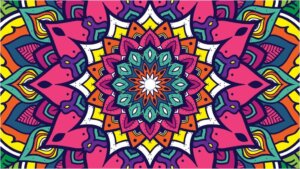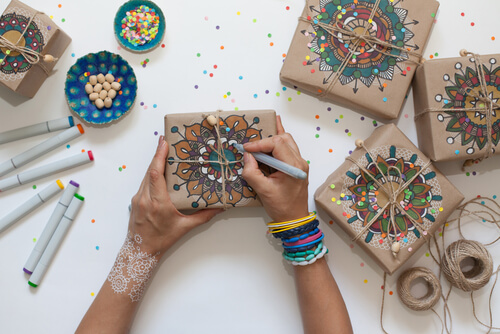The 11 Benefits of Mandalas


Written and verified by the psychologist Sergio De Dios González
What are the benefits of mandalas? The word mandala comes from Sanskrit and means “sacred circle.” These circle-shaped representations are used in different cultures. For example, Buddhist, Hindu, and Christian cultures. They’re also used by some indigenous tribes as artistic elements or as a means for an individual to find themselves.
According to the beliefs of certain cultures, mandalas are linked to the energies of life. For example, in Eastern cultures, it’s believed that each color is associated with a chakra. These energy centers are connected with our being and the environment. Moreover, they favor our well-being. The mandalas that contain them have the same function. They’re a wonderful, legendary technique with multiple benefits.
The surprising benefits of coloring mandalas
“A mandala is the psychological expression of the totality of the self.”
-Carl Jung-
Mandalas can vary in color and design, but basically, they’re formed by a center and different figures in the four cardinal points. In this regard, it’s believed that on a psychological level, they can represent the totality of our being. According to some advocates of this practice, each person responds to them instinctively, regardless of their age, gender, race, culture…
The magic of mandalas, and at the same time their therapeutic power, consists in letting ourselves be carried away by the unconscious mind, without worrying about the final result of the drawing. That is, without judging whether it’s looking good or bad, beautiful or ugly… We only need to be present and concentrated and give ourselves the freedom to color as we wish.
1. Mandalas produce relaxation
Designing and coloring mandalas helps to focus your attention. Therefore, they’re an excellent exercise to calm any feelings of stress and clear your mind. In fact, mandalas are designed to free us from worries because they favor concentration on the present, which is why they’re a powerful relaxation tool.

2. Deep connection, one of the surprising benefits of mandalas
Mandalas make it easier for you to connect with your inner self, thus promoting self-knowledge. They’re a wonderful exercise in reflection on your place in the world and the relationships you have with others. These artistic representations encourage us to connect with the deepest forces of ourselves and the universe through the energies that flow with each shape and color.

3. They favor meditation
According to a study published by the University of Lima, Perú in 2019, mandalas are a form of meditation that helps you focus your attention. They promote harmony. That’s because energies flow through their shapes and colors, transforming negative aspects into positive ones and bringing balance to your life.
It’s worth remembering that mandalas are arranged from the center outwards. This allows you to connect, rebuild, relate, and free yourself. This occurs via projection due to your selection of colors and figures.
4. Creativity and mandalas
Mandalas are an artistic representation of free design. You can draw them however you want. That said, if you don’t feel like designing them yourself, you can also buy books and notebooks containing them for you to color in. There are many different kinds available.
An interesting aspect of mandalas is that they are related to creativity because they allow the use of colors and shapes with total freedom. In other words, they facilitate the creative process and are a source for generating new ideas. In addition, each figure and color represent unconscious aspects of the person. Some of their meanings are the following
- Red. Passion, sensuality, strength, power, and aggressiveness. First chakra.
- Orange. Pleasure, glory, vanity, progress, and energy. Second chakra.
- Yellow. Joy, will, and novelty. Third chakra.
- Green. Hope, ease, and nature. Fourth chakra.
- Blue. Tranquility, seriousness, respect, and communication. Fifth chakra.
- Violet. Meditation, creativity, and oscillation. Sixth chakra.
- White. Peace, harmony, kindness, delicacy, and shyness. Seventh chakra.
- Black. Depth, mystery, authority, dignity, security, sadness, and mourning.
- Circle. Dynamism and connection with the cosmos.
- Cross. The unconscious and conscious, the union of heaven and earth.
- Triangle. Transformation and vitality.
- Square. Stability and balance.
- Labyrinth. The search for the center itself.
“Flow with whatever may happen and let your mind be free: Stay centered by accepting whatever you’re doing.”
-Zhuangzi-
5. Mandalas for decoration
Mandalas can also be used to decorate your home or workplace. Here are some decorative ideas:
- Paint mandalas on stones and use them as ornamental objects.
- Knit a mandala and use it as a blanket.
- Put a mandala tapestry on the wall.
- Make decorative pictures.

6. The therapeutic benefits of mandalas
Psychology has recognized mandalas as therapeutic elements. The Swiss psychologist Carl Jung suggested that they’re representations of our minds that facilitate concentration, transformation, and the assimilation of unconscious aspects. He suggested that we can project what we feel and think onto mandalas.
In addition, different branches of psychology have spoken of their benefits. Transpersonal psychology considers mandalas as an exercise to foster deep connection. Cognitive and behavioral psychology are tools to improve higher functions such as memory, attention, perception, and visual-motor coordination.
These visual representations are also used in other fields like occupational therapy, for instance. Through cognitive stimulation, they favor performance in daily activities. In addition, they’re used in educational environments to facilitate concentration, attention, and discipline.
7. Mandalas offer an opportunity to express ourselves
Life is full of ups and downs, and we often need a space where we can vent and express difficult experiences. To do this, we can talk to someone we trust or write how we feel but, if we prefer, we can also express ourselves through mandalas.
In this case, said art is an excellent tool to accept, express, and transform our emotional states that are difficult to process. In fact, it’s a very useful means to manage those feelings and emotions that are at a more unconscious level.
8. The rational part of us is allowed to rest
Day-to-day routines make the rational part of the brain (left hemisphere) work more. On the other hand, the creative part (right hemisphere) may be less overactivated. Therefore, when painting mandalas, the right and left hemispheres come together at the same level of collaboration, as supported by the following research developed in 2019 at the University of Valladolid in Span.
9. You dedicate time to yourself while strengthening your immune system: One of the most enriching benefits of mandalas
Painting mandalas not only contributes to improving the psychological and personal state but also, with this activity, the immune system is stimulated. In fact, as suggested by the following study developed at the National University of Rosario in Argentina, concentration is improved, pain is reduced, and sleep is also promoted.
10. Coloring mandalas connects you with your inner child
Coloring is an activity that we usually associate with childhood. As we become adults, we tend to put away colored pencils and markers except to underline notes or reports. However, this hobby can be very beneficial not only because it generates well-being and tranquility but also because it stimulates different brain areas related to the senses and creativity.
In this regard, coloring can be considered an act of meditation in itself because it helps us focus our thoughts on the activity we’re carrying out and connect with our creativity and our inner child. In moments, everything fades, and it’s just you, the colors, and the drawing.
11. Promotes motor skills
The development of fine motor skills, especially in childhood, is very important. Therefore, if you want to enhance this process, coloring the geometric shapes of the mandalas helps people perfect the coordination of hand movements and also enhances vision.
Furthermore, as revealed by the following research developed in 2019 within the Technical University of Ambato, Columbia, carrying out this activity is recommended in classrooms. This is especially true if learning experiences generate a lack of motivation, lack of creativity, or boredom for some students
Open the door to the benefits of mandalas in your life
As you can see, there are many benefits that you can obtain from mandalas. These artistic representations are a source of relaxation and liberation and have a deep creative power. Why not give them a try?
“Each mandala is unique and unrepeatable… It is the vibrational expression of this instant, of this now.”
-Celina Emborg-
All cited sources were thoroughly reviewed by our team to ensure their quality, reliability, currency, and validity. The bibliography of this article was considered reliable and of academic or scientific accuracy.
- Añaños, E., Estaún, S., Tena, D., Mas, T.M., y Valli, A. (2008). Psicología y comunicación publicitaria. Barcelona, España: Bellaterra.
- Celina Emborg – Artista Visual – Taller de pintura. Mandalas, Arte abstracto. (n.d.). Retrieved December 9, 2022, from Celina Emborg website: https://emborg.com.ar/
- Constanzo Baeza, M., Pino Duarte, Y., & Placencio Naranjo, K. (2019). Mandalas: una técnica ancestral para desarrollar la atención y la concentración con estudiantes con TEL mixto de una escuela de lenguaje de Maipú.
- Da Rós Albano, A. (2014). Mandalas, entre lenguaje y dispositivo de comunicación. Facultad de Ciencia Política y Relaciones Internacionales.
- Dahlke, R. (2004). Mandalas, como encontrar lo divino en ti. Un libro para encontrar la meditación y el dibujo y coloreado de los distintos mandalas. Barcelona, España: Robbin Book.
- Farelo López, P. (2019). El dibujo como metodología educativa: el arte de los Mandalas. Universidad de Valladolid.
- Jung, C. (1972). Concerning Mandala Symbolism. In Mandala Symbolism: (From Vol. 9i Collected Works) (pp. 71-100). Princeton: Princeton University Press. https://doi.org/10.1515/9781400886043-005
- Martínez Cruz, M.C. (2008). Los mandalas: esos grandes desconocidos, 1(3), 1-7.
- Molas, Silvia. (2021, March 2). Taller de Mandalas. Retrieved December 8, 2022, from website: https://silviamolas.com/es/taller-de-mandalas/
- Vazquez, B. (2019). “EL EFECTO DE LA TÉCNICA DE LAS MÁNDALAS EN EL NIVEL DE ATENCIÓN DE LOS ESTUDIANTES DE LA I.E.P. 71001 ALMIRANTE MIGUEL GRAU DE PUNO, 2018” [Tesis, ]. http://renati.sunedu.gob.pe/handle/sunedu/744004
This text is provided for informational purposes only and does not replace consultation with a professional. If in doubt, consult your specialist.








